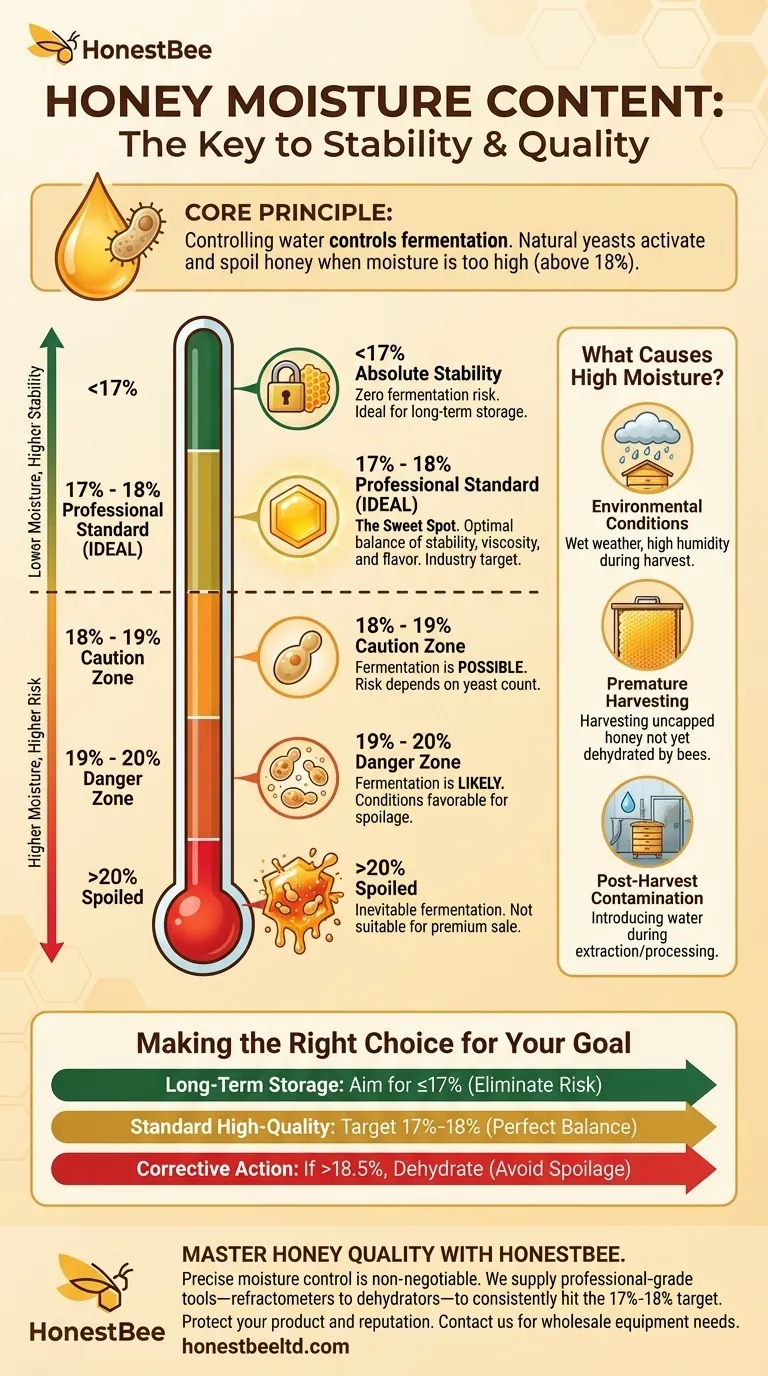The ideal moisture content for honey is the single most important factor in ensuring its long-term stability and quality. For beekeepers and producers, the target range is between 17% and 18%. While honey can be stable up to 20%, moisture levels below 18% effectively prevent fermentation, which is the primary cause of spoilage.
The core principle is simple: controlling water controls fermentation. Honey contains natural yeasts, which become active and spoil the product if the water content is too high. Staying below the 18% threshold is the most reliable way to guarantee preservation.

Why Moisture Content Dictates Honey's Fate
Honey is a supersaturated sugar solution, making it naturally resistant to spoilage. However, this stability is entirely dependent on keeping its water content low.
The Role of Yeast in Fermentation
All raw honey contains wild, osmophilic (sugar-tolerant) yeasts. These yeasts remain dormant and harmless as long as the water content is low.
When moisture rises, it effectively dilutes the sugar concentration. This awakens the yeast, which begins to consume the sugars and produce alcohol and carbon dioxide, spoiling the honey's flavor, aroma, and texture.
Below 17%: The Zone of Absolute Stability
At a moisture level of 17% or less, there is simply not enough free water available for any yeast to become active. Honey in this range is exceptionally stable and will not ferment, regardless of the yeast count.
17% to 18%: The Professional Standard
This range is the "sweet spot" for high-quality honey. It is low enough to ensure stability against fermentation while retaining the characteristic viscosity and flavor profile consumers expect. Most grading standards and beekeeping best practices target this precise window.
Understanding the Trade-offs and Risk Zones
Exceeding the ideal moisture content introduces a direct and escalating risk of spoilage. Understanding these thresholds is crucial for any producer.
The Caution Zone: 18% to 19%
In this range, fermentation becomes possible. Whether it occurs depends on the specific yeast count in the honey. If the honey has a naturally high concentration of yeast, spoilage can begin. This is a risky zone that should be avoided.
The Danger Zone: 19% to 20%
Once moisture exceeds 19%, fermentation is likely. The conditions are now favorable for most wild yeasts to multiply and begin breaking down the sugars. Honey at this level is considered unstable and low-quality.
Above 20%: Inevitable Spoilage
Honey with a moisture content above 20% will ferment. The process is often rapid and cannot be stopped without pasteurization or significant dehydration. This honey is considered spoiled and is not suitable for sale as a premium product.
What Causes High Moisture in Honey?
High moisture is rarely a deliberate choice; it's typically the result of environmental factors or harvesting errors.
Environmental Conditions
Harvesting during a wet spring or in a consistently humid climate can result in honey with naturally higher water content. Bees have a harder time dehydrating nectar when the ambient humidity is high.
Premature Harvesting
Bees dehydrate nectar inside the hive, fanning their wings to evaporate water until it reaches the stable ~18% range. They then cap the honeycomb cell with wax. Harvesting uncapped or partially capped frames means you are collecting honey that is not yet "finished" and has a higher moisture content.
Post-Harvest Contamination
Introducing water during the extraction, filtering, or bottling process can inadvertently raise the final moisture content. This includes improper cleaning of equipment or processing in a highly humid room.
Making the Right Choice for Your Goal
Your target moisture level depends on your specific objective, from long-term storage to immediate sale.
- If your primary focus is long-term storage and maximum stability: Aim for a moisture content at or below 17% to completely eliminate any risk of fermentation.
- If your primary focus is producing a standard, high-quality product: Target the industry-standard range of 17% to 18% for a perfect balance of stability and texture.
- If you discover your honey tests above 18.5%: You must take corrective action, such as using a honey dehydrator, as the product is at significant risk of spoilage.
Ultimately, mastering moisture control is the defining skill in producing exceptional and shelf-stable honey.
Summary Table:
| Moisture Level | Status | Risk & Outcome |
|---|---|---|
| Below 17% | Absolute Stability | Zero fermentation risk, ideal for long-term storage. |
| 17% - 18% | Professional Standard | Optimal balance of stability, flavor, and texture. |
| 18% - 19% | Caution Zone | Fermentation is possible, depending on yeast count. |
| 19% - 20% | Danger Zone | Fermentation is likely; honey is unstable. |
| Above 20% | Spoiled | Inevitable fermentation; not suitable for sale. |
Master Honey Quality with the Right Equipment
Precise moisture control is non-negotiable for producing premium, shelf-stable honey. HONESTBEE supplies commercial apiaries and beekeeping equipment distributors with the professional-grade tools needed to consistently hit the ideal 17%-18% moisture target.
We provide the reliable supplies—from refractometers for accurate testing to honey dehydrators for corrective action—that protect your product and your reputation.
Ensure every batch meets the highest standard. Contact HONESTBEE today to discuss your wholesale equipment needs.
Visual Guide

Related Products
- Precision Honey Refractometer Instrument for Quality Assessment
- Digital Honey Refractometer for Precision Measurement of Optimal Honey Quality
- Premium Heat-Resistant Glass Honey Dipper
- Easy Use Manual Stainless Steel Honey Press for Honey Comb
- Natural Wood Honey Dipper for Tea Coffee and Desserts
People Also Ask
- Why is a honey refractometer important for beekeepers? Ensure Quality and Prevent Fermentation
- What are the key steps to using a honey refractometer? Ensure Honey Quality & Prevent Fermentation
- What is a honey refractometer and what is its purpose? Ensure Honey Quality and Prevent Spoilage
- How does a honey refractometer work? Ensure Honey Quality & Harvest Readiness
- What is a honey refractometer? The Essential Tool for Perfect Honey Quality



















